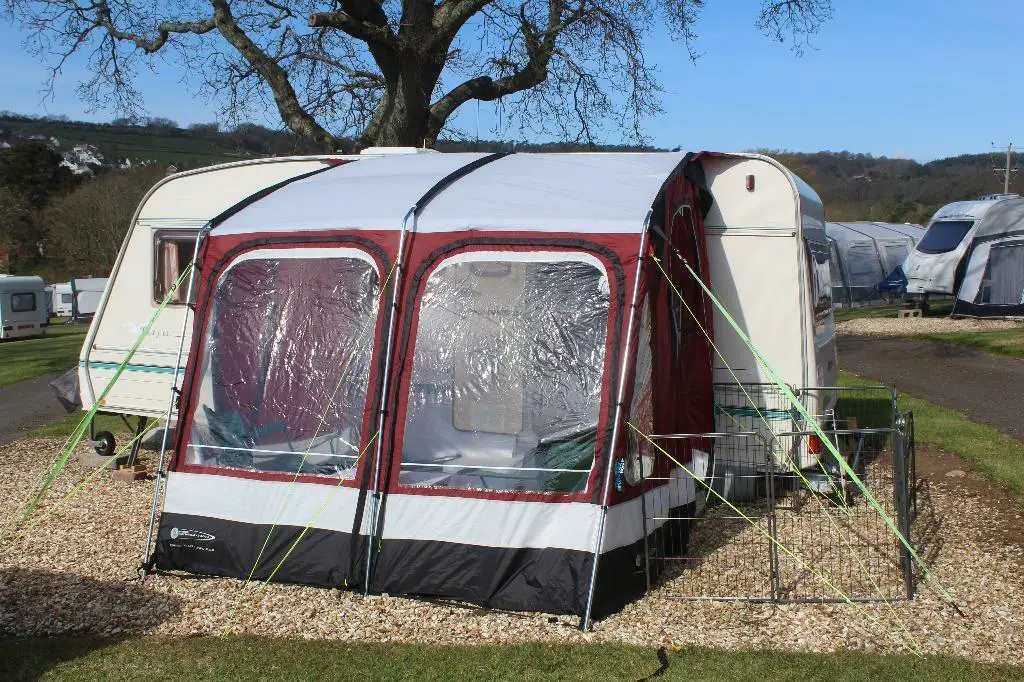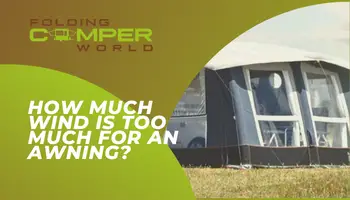If a caravan awning is exposed to really strong winds, it may be at risk of getting damaged. In fact, there is even a chance that the awning could damage your caravan because of these windy conditions. When left unattended during strong winds, the awning material will likely rip away from the track that secures it to the side of your caravan. Something to be aware of is that caravan awnings are usually not covered by insurance. This is because they are considered to be accessories and not a part of the caravan itself. In addition to this, insurance companies know that not all caravan awnings are built to handle strong winds, so if you chose to ignore the weather when it gets too windy, it’s not likely that they will offer any financial aid to help you fix your caravan.
So, how much wind is too much wind for an awning? This blog post will take a look at what other caravan users have said about this and the advice they give based on their experience. I will also suggest some effective ways that you can protect both your caravan and your awning during strong winds.
Many caravan users have explained that once the wind hits around 35mph, they keep a lookout on the weather as this is when their awning starts to blow around. Its also important to remember that all caravan awnings can withstand different types of weather conditions. Therefore, what might be tolerable for one awning may be too much for another. It is always best to check with the manufacturer before assuming how much wind your awning can take.
I will discuss the following in this blog post:
Advice from regular caravan users

While browsing on forums online, it became clear that one of the issues many caravan users struggle with while camping is knowing what do to when the wind starts to get stronger. It can be quite a confusing experience, especially if you are unsure if you need to go outside and take down your awning, or if you should let the winds continue and not risk your caravan from tipping over if you take the awning off. One online forum user (Davros18) on caravantalk.co.uk explained their experience and said:
“My scenario is, just over a week ago I took delivery of a new Dorema Escada Deluxe full awning, I put it up last weekend using Dorema storm straps, double pegged with 9” rock pegs and three additional storm straps, one on the apex and an additional strap at each corner. The awning was taught without being over tensioned.
On Thusday morning the awning gave up and blew over the roof of the caravan (luckily there is minimal damage to the van) all of the pegs and rubber ladders were still in the ground, the awning has failed at the point where the hooks for the ladders are stitched to the awning. I checked with the Met Office and the wind speeds on Thursday in the area averaged 21mph with gust to 46mph, my first thought is, I have learned a harsh lesson, but before I take the loss on the chin I thought I would ask you all for your opinion on whether you think it should have held up.”
This is a similar experience that a lot of campers share. The replies to this question were all quite similar. One user stated that they usually start to worry once the wind hits 35pmh and at this point, they keep an eye out for any possible damage. Another user says that they have had times where their awning has been perfect find at 60mph, but another time they started to see some damage to the awning at 40mph. This is most likely due to the direction that the caravan is parked in and the direction that the wind is blowing in.
Taking into consideration what the forum users said, It’s vital that you always check the weather forecasts and wind direction prior to setting off on your trip. Once you know the direction of the wind you can make sure that your caravan and awning are set up against the wind. This should keep the awning from being blown around too much by the wind. It is also important to make sure that all pegs are firmly in the ground and that the guy ropes are tightly secured. It’s also important to remember that all caravan awnings can withstand different types of weather conditions. Therefore, what might be tolerable for one awning may be too much for another. It is always best to check with the manufacturer before assuming how much wind your awning can take.
Protecting you caravan during strong winds

Here are some helpful tips on how you can try to keep your caravan safe during strong winds:
- Make use of tie-down kits: The tie-down kit helps to secure the awning to the ground. Although this is quite effective when used on its own, it works even better when used in addition to awning clamps. This gives the awning better stability and helps to make your set up more tolerant towards the high speed wind.
- Use awnings clamps: Manually operated caravan awnings can be reinforced with the use of awning clamps. These clamps help to reduce the fast movement of the fabric and prevent the awning from tearing away from the mounting rack. It important to not that these awning clamps do not guarantee to stop the awning from tearing, however, it does minimise the risk of this happening.
Conclusion
Hopefully, this blog post has explained the risks of using your awning during strong winds and how you can prevent these damages from occurring. As explained above, once the winds hit 35mph it’s best to keep an eye on the weather to make sure the awning or your caravan doesn’t get damaged. All caravan awnings can withstand different types of weather conditions, what might be tolerable for one awning may be too much for another. It is always best to check with the manufacturer before using your awning.


